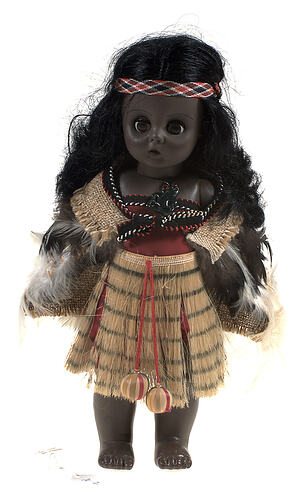Summary
Note: This object might be considered by some to be a cultural stereotype. Such representations are not condoned by Museums Victoria which considers them to be racist. Historical distance and context do not excuse or erase this fact.
National doll produced to represent a Maori woman. It was purchased for Monica Gates in Auckland, New Zealand in 1968. The doll is dressed in a skirt made of plant fibre and a rectangular cloak made of plant fibre and feathers, she also wears a woven headdress around her head.
The Gates collection contains 170 national dolls from 74 different countries and some correspondence relating to the acquisition of several of the dolls. The costumes of the dolls represent national costumes from the 19th Century to the 1990s. Monica Gates collected or was given these dolls between 1957 and 1990.
These dolls were purchased as souvenirs of particular countries and like many mass produced souvenirs they are often not accurate representations of a particular country or region, and may actually better reflect neighbouring counties or regions. This occurs because costumes are often stylised and simplified resulting dolls wearing generic costume elements which are common to many countries/regions. Often the fabrics and decorations used are selected to make the dolls cheap and easy to manufacture and aesthetically pleasing. This can result in the fabrics, colours and decorations of the doll's clothing having little or no reflection of the costume associated with a particular country or region they are meant to be representative of.
Physical Description
Doll, female Maori. She has long black hair and is wearing a grass skirt and a red cotton under dress. She has a feather cape around her shoulders and a green tiki around her neck. She also has a red and black head band and two raffia balls hanging from a string around her waist.
More Information
-
Collecting Areas
-
Acquisition Information
Purchase
-
Place Made
-
User
-
Other Association (See Comments)
New Zealand
Doll intended to represent a Maori woman in traditional dress -
Inscriptions
"N.Z." (-attached white paper tag)
-
Classification
-
Category
-
Discipline
-
Type of item
-
overall dimensions
195 mm (Width), 90 mm (Depth), 310 mm (Height)
-
Keywords
Children's Play, Clothing, Cultural Awareness, Cultural Beliefs, Dolls, National Costumes, National Identity, Souvenirs
